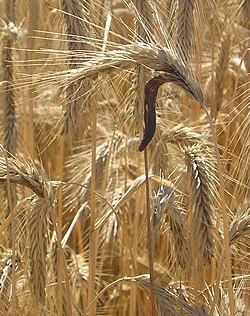Mycotoxicosis
Mycotoxicosis is a condition caused by the metabolic products of fungi, a disease of higher animals caused by the ingestion of mycotoxins. Mycotoxicosis includes fungal intoxication – one-time damage to health by toxic substances in fungi, especially macromycetes (typical tuberous toadstool poisoning) – and mycotoxicosis itself, which is poisonings by toxic metabolites released into the environment by micromycetes. These are mostly chronic, recurrent poisonings at lower doses, acute to fatal poisonings or conditions with chronic consequences that do not manifest immediately.
- Acute primary mycotoxicosis
After ingestion of a high dose of mycotoxins. Symptoms typical of individual toxins can even be fatal.
- Chronic primary mycotoxicosis
After long-term consumption of small or medium doses of mycotoxins. They are manifested by a slowing down in growth,and a reduced ability to reproduce.
- Secondary disease
After long-term use of very low doses.
Ergotism[edit | edit source]
The disease, is caused by ergot alkaloids, and the poisoning is by a toxin of Claviceps purpurea (ergot). Today, it occurs only in children who eat the ergot out of curiosity, it is treatable. In the Middle Ages, the occurrence was in epidemics, because the cause was not known, therefore it was not possible to eliminate it. It also acts as a teratogen.
- Vascular form
Spasms of small blood vessels dominate, with repeated exposure to toxins and after larger doses they lead to the death of acral parts of the body (ear lobes, nose, chin, lips, fingers, etc.). In the stage of acute poisoning, it can cause sudden transient blindness caused by small blood vessel spasm in the retina. In the Middle Ages, the disease was called "St. Anthony's Fire".
- Psychotropic form
In particular, physical and auditory hallucinations. Epidemics of ergotism were probably behind some witch trials (eg. Salem Witch Case, 17th century, USA).
Acute cardiac beriberi[edit | edit source]
The citreoviridine toxin, is produced by Penicillium citreoviride in rice (bright yellow color). Yellow rice detoxifies after exposure to the sun (the toxin is highly photolabile). In another type of yellow rice - pigmented skyrin (luteoskyrin, etc.) are present, they are not photolabile, they are hepatotoxic.
- Manifestation
Convulsions, paralysis, a significant arrhythmia in the heart ( Wenckebach periods ), can end in death (cardiac arrest in diastole). Unlike beriberi, it is not treatable with vitamin B1.
Alimentary toxic aleukia[edit | edit source]
Occurrence in the cereal strip (from southern Siberia to the Balkans). The disease is caused by T-2 toxin and related trichothecenes produced mainly by fungi of the genus Fusarium .The largest epidemic was in the 1940s in the then USSR (As a result of the war, the grain in the field remained under snow and was not harvested until the spring. 17,000 people died later, and the disease later occurred in the 1950s and 1960s and also in other countries, such as Hungary and France, and is now occasional in developing countries.)
The course of the disease
- 1. phase
Rapid onset of symptoms at the point of entry, usually the digestive system - inflammation of the mucous membranes, vomiting, diarrhea (even bloody), the toxin can penetrate the body with intact skin.
- 2. phase
Apparent relief, decrease in platelets and white blood cells.
- 3. phase
Patients are secondarily affected by a bacterial infection, which is a harmless flora for a healthy person, bleeding (there is a risk that women may bleed out during menstruation).
Several months of convalescence (for those who survive). An important supply of full-value proteins, which partially compensates for the decrease in proteosynthesis caused by trichothecenes.
The mechanism of action
Blockade of protein chain formation, initiation, prolongation and termination may be impaired. Tissues with high metabolic activity and rich proteosynthesis are mainly damaged. In sufficient concentration, it can also cause local, necrotizing effects. There is disruption of hemostasis (lack of protein coagulation factors). In addition, some toxins affect the relevant centres in the brain and cause anorexia, nausea and vomiting.
Diseases with the possibility of another etiology[edit | edit source]
Toxic hepatitis[edit | edit source]
Aflatoxins can cause inflammatory liver damage with chronic exposure. Other hepatotoxic mycotoxins, such as cyclochlorotine or luteoskyrin, may have a similar effect. The incidence of the disease in people is predominantly in developing countries and in the poor.
Primary hepatoma[edit | edit source]
Aflatoxins act as carcinogens.
Aflatoxin-induced Reye's syndrome[edit | edit source]
Rey's syndrome is a polyetiological disease state that can be caused by certain drugs, poisons, viral infections, etc. Aflatoxin is an etiological factor in infants under 1 year of age who are fed an artificial diet.
Rapid transition to severe unconsciousness after a febrile illness with non-specific virus-like symptoms. The coma shows the current severe damage to the liver and brain, which is also the cause of death.
Kwashiorkor[edit | edit source]
A close relationship was found between the incidence of the disease and food intake of aflatoxins (Ethiopia).
Other diseases[edit | edit source]
Attenuation of immunity, hyperestrogenism,…
References[edit | edit source]
External links[edit | edit source]
Literature[edit | edit source]
- VOTAVA, Miroslav, et al. Lékařská mikrobiologie speciální. 1. edition. Neptun, 2003. 495 pp. ISBN 80-902896-6-5.



